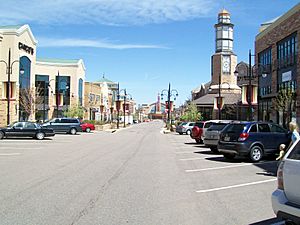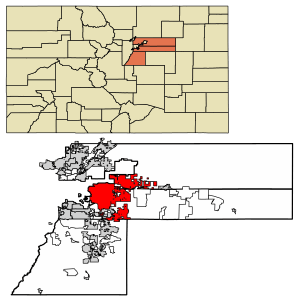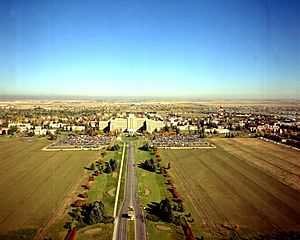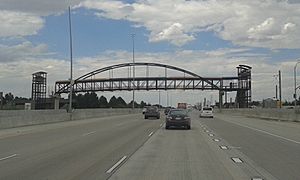Aurora, Colorado facts for kids
Quick facts for kids
Aurora
|
|||
|---|---|---|---|

The Southlands, an Aurora-based shopping mall
|
|||
|
|||
| Nicknames:
The Gateway to the Rockies
The Sunrise of Colorado |
|||

|
|||
| Country | |||
| State | |||
| Counties | Arapahoe Adams Douglas |
||
| Platted | 1891 as Fletcher, Colorado | ||
| Incorporated (town) | May 5, 1903, as the Town of Fletcher | ||
| Incorporated (city) | March 9, 1928 as the City of Aurora | ||
| Government | |||
| • Type | Home rule municipality | ||
| Area | |||
| • Total | 423.691 km2 (163.588 sq mi) | ||
| • Land | 422.191 km2 (163.009 sq mi) | ||
| • Water | 1.500 km2 (0.579 sq mi) | ||
| Area rank | 2nd in Colorado 54th in the United States |
||
| Elevation | 1,694 m (5,558 ft) | ||
| Population
(2020)
|
|||
| • Total | 386,261 | ||
| • Rank | 3rd in Colorado 52nd in the United States |
||
| • Density | 931/km2 (2,412/sq mi) | ||
| Demonym(s) | Auroran | ||
| Time zone | UTC−07:00 (MST) | ||
| • Summer (DST) | UTC−06:00 (MDT) | ||
| ZIP Codes |
80010-80019, 80040-80047 (all but 80045 PO Boxes), 80247
|
||
| Area codes | Both 303 and 720 | ||
| FIPS code | 08-04000 | ||
| GNIS feature ID | 2409757 | ||
Aurora is a large city in Colorado, United States. It is a "home rule municipality," which means it has the power to govern itself on local matters. The city is located across three different counties: Arapahoe, Adams, and Douglas.
In 2020, Aurora had a population of 386,261 people. This makes it the third-largest city in Colorado and the 52nd-largest city in the entire United States. Aurora is an important part of the larger Denver–Aurora–Lakewood Metropolitan Statistical Area.
Contents
Discovering Aurora's Past
Before European settlers arrived, the land where Aurora now stands was home to several Native American tribes. These included the Arapaho, Cheyenne, Núu-agha-tʉvʉ-pʉ̱ (Ute), and Očeti Šakówiŋ (Sioux) tribes.
How Aurora Began
Aurora started in the 1880s as a town called Fletcher. It was named after Donald Fletcher, a businessman from Denver. He saw a chance to develop land east of Denver. However, the town faced big problems after the Silver Crash of 1893, which was a major economic downturn.
The town of Fletcher officially became a town on May 5, 1903. Donald Fletcher left, and the community was left with a large debt for water. In 1907, voters decided to change the town's name to Aurora. This new name came from one of the original neighborhoods within the town. The Aurora post office opened in 1908.
Growing into a City
By February 1928, Aurora had grown to over 2,000 people. It was then officially recognized as a city on March 9, 1928. Aurora continued to grow steadily. In the late 1970s and early 1980s, it became one of the fastest-growing cities in the United States.
Aurora is made up of many different neighborhoods. Even though it's a large city, it feels more like a collection of suburbs. This is because it doesn't have a single, very tall downtown area like some older cities.
Military Presence in Aurora
Aurora has had a strong military presence for a long time. In 1918, Army General Hospital #21 opened. It was later renamed Fitzsimons Army Hospital. This hospital was expanded in 1941 to help care for soldiers wounded in World War II.
Lowry Air Force Base opened in 1938, right on the border of Aurora and Denver. It closed in 1994 and has since been redeveloped into a community with homes, businesses, and schools. In 1942, the Army Air Corps built Buckley Field. This base has changed names several times and is now called Buckley Space Force Base. It is home to the Buckley Garrison and the 140th Wing Colorado Air National Guard. Buckley Space Force Base is the largest employer in Aurora.
Many important people have visited Fitzsimons Army Hospital. Presidents Warren G. Harding and Franklin D. Roosevelt both visited. President Dwight D. Eisenhower even recovered there after a heart attack in 1955. The hospital closed in 1999. Today, the area is part of the Anschutz Medical Campus of the University of Colorado Denver. This campus includes the University of Colorado Hospital and the Children's Hospital. These medical facilities employ many people.
Key Moments in Aurora's History
In 1965, Norma O. Walker became the first woman to lead a U.S. city with over 60,000 people.
In 1993, Cherry Creek State Park in Aurora hosted a huge event. Pope John Paul II held a special mass there for World Youth Day. About 500,000 people attended.
Aurora has been recognized for its community efforts. In 2008, it was named an All-America City by the National Civic League.
The city is also known for its innovative water system. In 2010, Aurora became one of the first U.S. cities to use "bank filtration." This method siphons water from beneath a riverbed.
Recently, the Republic of El Salvador opened a consulate in Aurora in 2017. In 2024, the Republic of Honduras also opened a diplomatic office in the city.
Recent Events in Aurora
In 2019, a young man named Elijah McClain passed away after an encounter with Aurora police officers. This event led to protests and discussions about community safety.
Aurora also received national attention during the 2024 United States presidential election. Local officials and politicians discussed various community issues, bringing the city into the national spotlight.
Exploring Aurora's Landscape
Aurora's official elevation is 5,471 feet above sea level. However, the city's elevation changes quite a bit, by almost 1,000 feet. The lowest point is 5,285 feet in the northwest, and the highest point is 6,229 feet in the southern part of the city.
Aurora covers a total area of about 163.6 square miles (423.7 square kilometers). Only a small part of this area is water. Aurora is about 6% larger than its neighbor, Denver. It ranks as the 54th-largest U.S. city by land area.
Aurora's Many Neighborhoods
Aurora is made up of many different neighborhoods, districts, and former military sites. Some of these include:
- Adonea
- Anschutz Medical Campus
- Aurora Heights
- Aurora Highlands
- Aurora Hills
- Aurora Knolls
- Beacon Point
- Berkshire Village
- Blackstone
- Brookvale
- Buckley Space Force Base
- Carriage Place
- Centretech
- Chadsford
- Chaddsford Village
- Chambers Heights
- Chelsea
- Cinnamon Village II
- City Center
- Conservatory
- Copperleaf
- Corning
- Crestridge
- Cross Creek
- The Dam East
- Del Mar
- The Dam West
- Downtown A-Town
- Eastridge
- East Quincy Highlands
- Fox Hill
- Greenfield
- Hallcraft's Village East
- Hampton Hills
- Havana Heights
- Heather Gardens
- Heather Ridge
- Heritage Eagle Bend Golf Club
- Highline Villages
- Highpoint
- Hillside at Del Mar
- Hoffman Heights
- Hutchinson Heights
- Inspiration
- Jackson Farm
- Kingsborough
- Laredo-Highline
- Lowry Campus
- Lynn Knoll
- Meadowood
- Meadow Hills
- Mission Viejo
- Morris Heights
- Murphy Creek
- Peoria Park
- Pheasant Run
- Piney Creek
- Ponderosa Ridge
- Pride's Crossing
- Ptarmigan Park
- Queensborough
- Quincy Hill
- Rocking Horse
- Saddle Rock
- Settler's Village
- Serenity Ridge
- Seven Hills
- Shenandoah
- Stapleton
- Siena
- Smoky Hill
- Smoky Ridge
- Sterling Hills
- Stricker's House
- Summer Valley Ranch
- Tallgrass
- Tallyn's Reach
- The Timbers
- Tollgate Run at Kingsborough
- Tollgate Village
- Traditions
- Tuscany
- Utah Park
- Village East
- Waters Edge
- Wheatlands
- Whispering Pines
- Willow Park
- Willow Trace
- Woodgate
- Woodrim
Neighboring Cities
Aurora is surrounded by several other cities:
| North: Denver | ||
| West: Denver, Centennial | Aurora | East: Watkins, Bennett, Strasburg |
| South: Greenwood Village, Centennial, Foxfield, Parker |
Aurora's Climate and Weather
Aurora has a semi-arid climate, meaning it's generally dry. It experiences all four seasons. Summers are mild to hot with low humidity and often have afternoon thunderstorms. July is the warmest month.
Winters can be mild or very cold, with sunshine mixed with snow and strong winds. December is the coldest month. Snow usually falls from late October to late April. Hailstorms are also common during the warmer months.
| Climate data for Aurora, Colorado | |||||||||||||
|---|---|---|---|---|---|---|---|---|---|---|---|---|---|
| Month | Jan | Feb | Mar | Apr | May | Jun | Jul | Aug | Sep | Oct | Nov | Dec | Year |
| Record high °F (°C) | 76 (24) |
75 (24) |
83 (28) |
89 (32) |
97 (36) |
105 (41) |
108 (42) |
104 (40) |
100 (38) |
96 (36) |
81 (27) |
73 (23) |
108 (42) |
| Mean daily maximum °F (°C) | 45 (7) |
47 (8) |
55 (13) |
62 (17) |
71 (22) |
82 (28) |
89 (32) |
86 (30) |
78 (26) |
67 (19) |
53 (12) |
43 (6) |
65 (18) |
| Mean daily minimum °F (°C) | 18 (−8) |
20 (−7) |
26 (−3) |
33 (1) |
42 (6) |
51 (11) |
57 (14) |
55 (13) |
47 (8) |
35 (2) |
26 (−3) |
17 (−8) |
36 (2) |
| Record low °F (°C) | −32 (−36) |
−24 (−31) |
−14 (−26) |
−7 (−22) |
17 (−8) |
30 (−1) |
41 (5) |
36 (2) |
15 (−9) |
−2 (−19) |
−14 (−26) |
−27 (−33) |
−32 (−36) |
| Average precipitation inches (mm) | 0.49 (12) |
0.47 (12) |
1.50 (38) |
2.08 (53) |
2.85 (72) |
2.00 (51) |
2.46 (62) |
2.05 (52) |
1.44 (37) |
1.03 (26) |
1.18 (30) |
0.65 (17) |
18.20 (462) |
| Source: Weather.com | |||||||||||||
Aurora's Population and People
| Historical population | |||
|---|---|---|---|
| Census | Pop. | %± | |
| 1900 | 202 | — | |
| 1910 | 679 | 236.1% | |
| 1920 | 983 | 44.8% | |
| 1930 | 2,295 | 133.5% | |
| 1940 | 3,437 | 49.8% | |
| 1950 | 11,421 | 232.3% | |
| 1960 | 48,548 | 325.1% | |
| 1970 | 74,974 | 54.4% | |
| 1980 | 158,588 | 111.5% | |
| 1990 | 222,103 | 40.1% | |
| 2000 | 276,393 | 24.4% | |
| 2010 | 325,078 | 17.6% | |
| 2020 | 386,261 | 18.8% | |
| U.S. Decennial Census | |||
Aurora has grown a lot over the years. In 2010, there were 325,078 people living in the city. The population density was about 1,940 people per square mile.
Diversity in Aurora
Aurora is a very diverse city. In 2010, about 61.1% of the population was White, 15.7% African American, and 4.9% Asian. Many different Asian groups live in Aurora, including Korean, Vietnamese, Filipino, and Chinese communities. About 1% of the population was Native American and 0.3% Pacific Islander.
A large part of Aurora's population, 28.7%, identifies as Hispanic or Latino. This includes people of Mexican, Salvadoran, Puerto Rican, and other backgrounds.
Aurora is also a welcoming place for refugees. Many people from Ethiopia and Eritrea have made their homes in the Denver–Aurora area. There is also a significant community of Nepalese refugees.
In 2010, about 35.5% of households in Aurora had children under 18. The average household had 2.6 people. The median age in the city was 32 years old.
Aurora's Economy and Jobs
Aurora has many job opportunities. The largest employers in the city are a mix of public and private organizations.
Major Employers in Aurora
Here are some of the biggest employers in Aurora:
| # | Employer | Employees |
|---|---|---|
| 1 | Buckley Space Force Base | 12,100 |
| 2 | Anschutz Medical Campus | 6,360 |
| 3 | University of Colorado Hospital | 4,050 |
| 4 | Aurora Public Schools | 4,020 |
| 5 | Cherry Creek Schools | 3,820 |
| 6 | City of Aurora | 3,740 |
| 7 | Community College of Aurora | 510 |
The largest private employers include:
| # | Employer | Employees |
|---|---|---|
| 1 | Children's Hospital Colorado | 5,670 |
| 2 | Raytheon Technologies | 2,430 |
| 3 | Kaiser Permanente | 1,940 |
| 4 | The Medical Center of Aurora | 1,710 |
| 5 | Amazon | 1,500 |
| 6 | 24-7 Intouch | 1,350 |
| 7 | SROriginals | 870 |
| 8 | Tyco Integrated Security | 850 |
| 9 | Northrop Grumman | 750 |
| 10 | ADT Inc. | 700 |
Other important companies in Aurora are Lockheed Martin Corporation, Staples Inc., and Amazon.
Fun Things to Do in Aurora
Aurora offers many parks, open spaces, and natural areas. The city manages over 100 parks and more than 6,000 acres of natural land. There are also six city-owned golf courses.
Outdoor Adventures
- Star K Ranch is a great place to see wildlife. It has trails and access to the Sand Creek Greenway Trail.
- Jewell Wetland is a 50-acre wooded wetland with trails, boardwalks, and a butterfly garden.
- Aurora Reservoir and Quincy Reservoir are perfect for water activities like fishing and boating.
- DeLaney Farm has 130 acres of open space and trails. It also features an organic garden and historic buildings.
- The Plains Conservation Center has 1,100 acres of prairie. It offers educational programs about the local environment.

History and Culture
Aurora manages 27 historic sites and landmarks. These include old farmhouses, a Victorian-style home, and the unique DeLaney Round Barn built in 1902.
- The Aurora Fox Theatre & Arts Center is a historic theater. It hosts plays and other performances.
- The Aurora History Museum shares the story of Aurora. It has exhibits on the city's past and art.
- The Colorado Freedom Memorial and a memorial garden honor victims of a past tragedy.
- The Aurora Symphony Orchestra performs concerts throughout the year.
- The Aurora Public Library has several branches. It offers books, computers, and events for everyone.
Shopping and Entertainment
- Town Center at Aurora is the city's main shopping mall.
- Other shopping areas include The Gardens on Havana and Southlands.
- Stanley Marketplace is a unique shopping center. It is located in a former aviation plant.
Learning in Aurora
Aurora has several school districts for primary and secondary education:
- Aurora Public Schools
- Bennett School District 29-J
- School District 27J (Brighton Public Schools)
- Cherry Creek Public Schools
- Douglas County School District
There are also charter schools like DSST Public Schools and private schools such as Christ Our Redeemer Lutheran School.
For higher education and career training, Aurora offers:
- University of Colorado Anschutz Medical Campus
- Columbia College–Aurora
- Community College of Aurora
- Pickens Technical College
- Colorado School of Holistic and Naturopathic Studies
- Colorado Technical University–Denver South Campus
- Concorde Career College
- Platt College
Getting Around Aurora
Major highways like I-70, I-225, and the E-470 beltway run through Aurora.
The city also has a light rail system. The H Line and R Line connect parts of Aurora. The R Line also connects to the A Line, which goes to Denver International Airport. Aurora is actually closer to the airport than Denver itself.
In 2017, Aurora started a bike-sharing program. This allowed people to rent bikes easily. However, the program has been paused since August 2022.
Sports in Aurora
Aurora is a city that loves sports. In 2004, Sports Illustrated magazine named Aurora Colorado's "Sportstown." This was because of the city's great support for sports.
The Aurora Sports Park opened in 2003. It hosts many regional and national sports tournaments each year. In 2014, Aurora hosted major powerlifting championships, including the IPF Open World Championships.
Famous People from Aurora
Many notable individuals have connections to Aurora, including:
- Lauren Boebert, a U.S. Representative
- Zachery Ty Bryan, an actor
- J. Scott Campbell, a comic book artist
- Michael Chiesa, a UFC fighter
- Mike Coffman, the current Mayor of Aurora
- Danny Dietz, a former Navy SEAL
- John Kerry, a former U.S. Senator and Secretary of State
- Andrew Kwon, a fashion designer
- Joe Neguse, a U.S. Representative
- Brendan Schaub, a former mixed martial arts fighter and comedian
- Dan Soder, a stand-up comedian
- Michelle Waterson, a mixed martial arts fighter
- Bowen Yang, an SNL cast member
Aurora's Global Connections
Aurora has "sister cities" and "friendship cities" around the world. These connections help promote cultural exchange and understanding.
Sister Cities
 Adama, Ethiopia (since 2014)
Adama, Ethiopia (since 2014) Chihuahua, Mexico (since 2023)
Chihuahua, Mexico (since 2023) Jacó, Costa Rica (since 2016)
Jacó, Costa Rica (since 2016) Seongnam, South Korea (since 1992)
Seongnam, South Korea (since 1992)
Friendship Cities
 Antiguo Cuscatlán, El Salvador (since 2016)
Antiguo Cuscatlán, El Salvador (since 2016) New Taipei City, Taiwan (since 2023)
New Taipei City, Taiwan (since 2023)
Images for kids
See also
 In Spanish: Aurora (Colorado) para niños
In Spanish: Aurora (Colorado) para niños
















